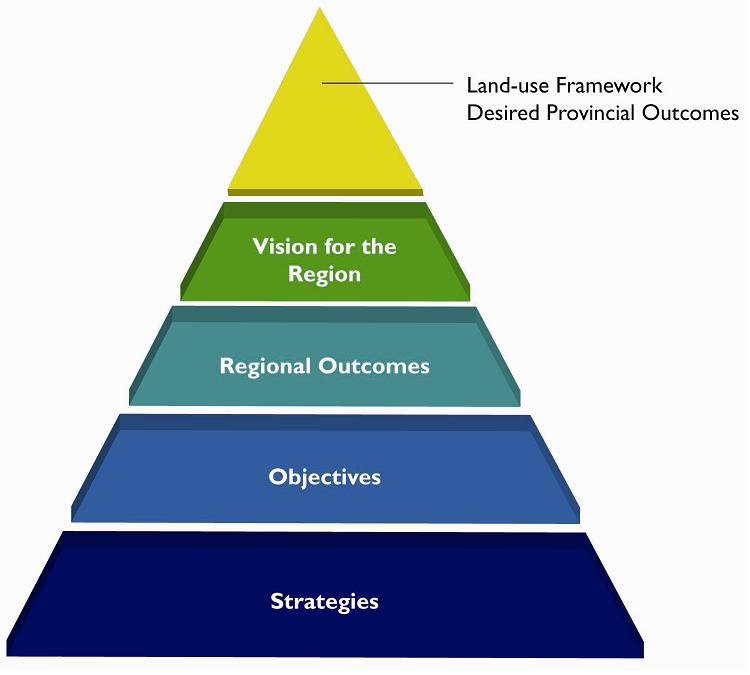Outcomes and Objectives
Through regional plans, a regional vision, outcomes and objectives are established, along with strategies and actions that will be used to achieve them. Supporting indicators help assess whether desired regional and provincial outcomes are being achieved.
Regional Vision
The regional vision describes the desired future state of the region, and is consistent with the outcomes and principles of the Land-use Framework. The regional vision also reflects the Land-use Framework vision of Albertans working together to respect and care for the land as the foundation for our economic, environmental and social well-being.
|
For example, the vision for the South Saskatchewan Region is:
Southern Alberta is a diverse, healthy, vibrant and prosperous region where the natural beauty of the region is managed so that citizens feel connected to the land and its history. Albertans, industry, governments and aboriginal peoples work together to share responsibility for stewardship of the land and resources in a way that ensures current needs are met without compromising opportunities for future generations. Aboriginal peoples, through their traditional knowledge, share their intimate understanding of the region's natural environment and ecosystems.
The South Saskatchewan Region supports a diverse and growing population. Economic diversification supports employment and contributes to a properous future. Agriculture is a significant renewable resource industry demonstrating environmental stewardship while pursuing growth and diversification opportunities. There are continued opportunities for oil and natural gas production and renewable energy will become increasingly significant. Forests are managed with watershed management and headwaters protection as the highest priority, and healthy forests continue to contribute to the province's timber supply. The region has unique landscapes that form the basis of a popular tourism and recreation destination which continues to grow.
Air, water, land and biodiversity are sustained with healthy functioning ecosystems. The headwaters in the region supply vital regional fresh water quality. Conservation strategies help many species at risk in the South Saskatchewan Region recover, while also preserving the diversity and splendor of Alberta's natural regions with various parks and conservation areas providing Albertans with improved health and inspiration to value nature. |
Desired Regional Outcomes
To support achievement of the three province-wide outcomes and the regional vision, a regional plan identifies regional outcomes. These qualitatively describe what we wish to achieve at the regional level.
|
For example, the Lower Athabasca Regional Plan identifies the following seven regional outcomes:
-
Improving the integration of industrial activities on the landscape;
-
Encouraging timely and progressive reclamation of disturbed lands;
-
Managing air, water and biodiversity through management frameworks that take proactive approaches and set limits and triggers and by minimizing land disturbance in the region;
-
Creating new conservation areas that are large, interconnected and maintain intact habitat to support biodiversity;
-
Strengthening infrastructure planning to support future growth of the region;
-
Designating new recreation and tourism areas to provide diverse recreation opportunities to local residents and tourism products for visitors to the region; and
- Inclusion of aboriginal peoples in land-use planning.
|
Regional Objectives and Strategies
A number of objectives are identified for each regional outcome and describe what must be done to achieve the outcome. Strategies describe regulatory and non-regulatory approaches that will be used to achieve each objective.
|
For example, within the Lower Athabasca Regional Plan the fourth outcome - air and water are managed to support human and ecosystem needs - is associated with the following air quality objective: releases are managed so they do not collectively result in unacceptable air quality. In turn, this is associated with the strategy of implementing an Air Quality Management Framework for the Lower Athabasca Region. |

Regional Supporting Indicators
As a means of assessing whether regional outcomes and objectives are being achieved, a series of economic, environmental and social indicators will be regularly monitored, evaluated and reported.
|
In the above example, the supporting indicators are nitrogen dioxide and sulphur dioxide. If monitoring indicates an ambient air quality trigger or limit has been exceeded, there will be a regional management response. The environmental management framework describes the kinds of management actions that may be required and commits to ongoing monitoring, evaluation and reporting. |
Shift to a Cumulative Effects System
Various governments, ministries and agencies will work together in an integrated manner as they develop the required system and tools to support implementation of the regional plan. While strategies and actions each fall primarily into the mandate of one or more ministries, it is important to note that a government-wide approach will be taken to implement the strategies. This is part of the shift to a cumulative effects management system as envisioned by the Land-use Framework.
